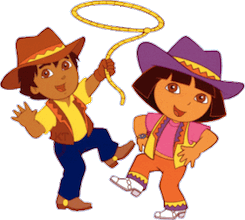 Learning about cultures and ways of life that are different from those that your children are familiar with is an important part of growing up; as he ages and spends more time with people outside of his immediate family and childcare providers, he will encounter an entire world of people whose ideas and customs are different from his own. Though there has been a significant push in severely limiting or eliminating kids’ exposure to television shows, there are some valuable lessons that children can learn from these brightly colored animated adventures.
Learning about cultures and ways of life that are different from those that your children are familiar with is an important part of growing up; as he ages and spends more time with people outside of his immediate family and childcare providers, he will encounter an entire world of people whose ideas and customs are different from his own. Though there has been a significant push in severely limiting or eliminating kids’ exposure to television shows, there are some valuable lessons that children can learn from these brightly colored animated adventures.
- Focusing on Cultural Diversity Education – Some cartoons, like The Misadventures of Maya and Miguel, are focused primarily on both presenting realistic depictions of different ethnicities to non-minority children and providing children from similar ethnic backgrounds with characters that look, sound, and live the same way they do.
- Depicting Everyday Situations – Rather than underscoring every reference to non-minority culture with heavy-handed preaching, cartoons tend to center around characters in ordinary situations (or extraordinary, if the shows are fantasy-based) that simply happen to be from a different cultural background.
- Featuring Characters from Various Ethnic Backgrounds and Walks of Life – Cartoons that feature large groups of characters working together, striving for a common goal, or simply interacting with one another regularly tend to do so with a racially and culturally mixed group. The things that make these characters different may be touched upon in specific episodes, but they’re most often simply accepted, as the main focus is on finding adventures or overcoming obstacles together.
- Musical Diversity – Music and children’s television tend to go hand in hand, and cartoons that feature diverse “casts” also tend to include music from a variety of cultural and ethnic backgrounds. Kids may be prompted to sing along with their favorite characters in another language, or mimic dances associated with other cultures.
- Discussing Cultural Ceremonies and Traditions – Jewish characters may discuss a bar or bat mitzvah, animated Latina girls may get excited about their quinceanera, and Christian cartoon characters often celebrate Christmas or other religious holidays. These frank depictions of cultural ceremonies observed by characters from various backgrounds and ethnicities help kids to see beyond the scope of the ones celebrated in their own households.
- Foreign Language Instruction – Cartoon juggernaut Dora the Explorer opened the floodgates for early education in second languages; while she still holds the crown as the undisputed princess of animated language instruction, followers like Ni Hao, Kai-Lan and others of her ilk have created an entire cartoon subculture centered around teaching diversity by teaching basic second-language vocabulary.
- Creating Talking Points for Parents and Kids – When kids watch cartoons and are exposed to unfamiliar cultural and ethnic depictions, their natural reaction is to question their parents and caregivers about the things that they don’t understand. By presenting different cultures and diverse groups to small children, cartoons are also presenting parents with a priceless opportunity to discuss such things with them.
- Eschewing Stereotypes – In cartoons, a girl might take the lead while a boy shows reticence; stereotypes are broken and disregarded in cartoons today. While this attitude is in direct opposition to the sometimes-racist cartoons with rigid gender roles in the days of yore, kids today are not being conditioned by their animated entertainment to view the world in such ways.
- Presenting Diversity to Culturally Isolated Kids – Some kids grow up in rural areas, or fairly homogenous neighborhoods, and have limited interaction with kids from other backgrounds. For these kids, high-quality cartoons provide a glimpse into those backgrounds and expose them to cultural differences that they might otherwise be unaware of.
- Direct Imports – It’s difficult to dispute the huge impact that Japanese cartoons have had on the global landscape. Collecting and merchandising crazes spurred by imported shows like Pokemon are the stuff of legend; they’re also chock full of references to Japanese culture, more often than not.
Exposure to high-quality children’s programming, in moderation and paired with a significant amount of physically active play, can help kids form a well-rounded world view at an early age. Screening the shows that your kids watch for any questionable content, like excessive violence or lack of educational merit, can help you find shows that keep your kids entertained as they learn; rather than taking an all-or-nothing approach to children’s television, allowing a limited amount of high quality programming that introduces them to new concepts and ways of life might actually prove to be beneficial.
Taken From National Nannies
Newstyle Print offers high end, low cost banner printing in the UK.. like review goals which understand the cost of passing on the amazing strong asset futile out of pocket. I truly worshiped examining your posting. Grateful to you! 바카라 게임 규칙
ReplyDelete